

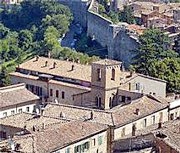
View of the remains of San Tommaso
from the path to Porta Pesa (see Walk VI)
According to Annibale Mariotti, who was writing in 1787, Pope Gregory IX established a Cistercian nunnery here in 1235 that was dedicated the Virgin. He also established a second such nunnery outside Porta Sant’ Antonio that was dedicated to St Elizabeth of Hungary (and later to St George - see below). Unfortunately, the relevant papal bull no longer survives. The earliest surviving documentation dates to 1274, when the Bishop of Perugia sought alms on the behalf of what was by then the Cistercian nunnery of San Tommaso.
Again according to Annibale Mariotti, the community at San Tommaso was united with that of San Giorgio in 1369. (It is likely that their site outside the city walls was in some danger of attack at that time). However, the two communities seem to have retained their separate identities until they were formally united by Pope Martin V in 1420.
In 1479, the nuns of San Giacomo Vecchio, Bettona suffered a fire, after which they sought permission from Pope Sixtus IV to move to San Tommaso. This was strongly opposed by Bishop Barnaba Bennati of Assisi. The matter was subjected to arbitration, and the decision was announced in 1483 in favour of the new bishop of Assisi, Francesco Insegna. A few of the nuns from Bettona decided to remain at San Tommaso, while the rest moved to a new nunnery inside the walls of Bettona.
The campanile of San Tommaso was rebuilt in 1459, as part of a programme of restoration. Further restoration work is recorded in the 1520s. Pope Paul III granted exemption from papal taxes in 1535 and made other financial contributions to the nunnery.
In 1555, Bishop Ippolito della Corgna received permission from Pope Julius III to call three Dominican nuns from San Paolo, Orvieto to reform the nunnery, and it subsequently passed to the Dominican Order and the authority of San Domenico. In 1558, the procurator of San Domenico commissioned a new organ for his own church and a second for the nuns of San Tommaso.
In 1566, Pope Pius V issued the bull Circa Pastoralis, which decreed that tertiary nuns other non-cloistered female communities should take solemn vows and adopt clausura. The nuns tried to resist but, following an apostolic visitation, Monsignor Paolo Maria della Rovere, Bishop of Cagli in 1571, were forced to accede.
Extensions to the nunnery continued throughout the second half of the 16th century, as San Tommaso became one of the largest and most prosperous of the nunneries in the city. The church was restored in the 18th century, after which it was reconsecrated by Bishop Alessandro Maria Odoardi in 1785.
In 1810, the community suffered the confiscation of some of its works of art (see below). It was suppressed in 1864, but the nuns were allowed to continue living in a small part of the ex-nunnery. These nuns, together with those from the Monastero della Beata Colomba in Corso Cavour who had moved to Via Imbriani, all moved to what became the Monastero della Beata Colomba in Corso Garibaldi in 1940.
By 1908, the nuns’ church had been deconsecrated and adapted for other uses. The nunnery housed the headquarters of the Fascist Party in the 1940s. The complex now houses:
-
✴the Scuola Media Ugo Foscolo; and
-
✴Perugia Officina per la Scienza e la Tecnologia (POST).
Surviving Structure
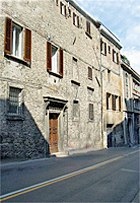
-
✴the view of the campanile from the path to Porta Pesa (see Walk VI) is illustrated above;
-
✴this photograph shows the entrance to the ex-nunnery, at 62 Via Pinturicchio;
-
✴the facade of the ex-church now fronts the garage at number 60; and
-
✴the portal at number 58, which reproduces the words of St Thomas to the risen Christ (Dominus Meus et Deus Meus - My Lord and my God) must have come from the nunnery.
Frescoes (17th century)
These frescoes in what was the choir of the church (now part of the gymnasium of the Scuola Media Ugo Foscolo) depict four Dominican saints:
-
✴Raymond of Penafort;
-
✴Albert the Great;
-
✴Peter Martyr; and
-
✴Thomas Aquinas;
set in a background of a grotesque motif. They are attributed, somewhat tentatively, to Matteuccio Salvucci.
Apotheosis of St Thomas (18th century)
This interesting brochure produced by pupils of the school celebrates the internal restoration of the complex. Its main subject (illustrated on the front page and described inside) is the recently-uncovered fresco above in the vaults above the entrance of the ex-church. This is clearly part of the perspectival fresco set in a loggia with doric columns that Baldassare Orsini recorded in 1784. He attributed it to a follower of Andrea Pozzo, clearly referring to the similarity of the design to that of the the frescoes (1685-94) of the Apotheosis of St Ignatius in the vaults of Sant’ Ignazio di Loyola, Rome.
It is clear from the description of a guide of 1822 that the frescoes in San Tommaso depicted the Apotheosis of St Thomas. In the surviving part of the fresco, the architectural setting houses a number of angels playing musical instruments and the vestiges of two allegorical figures, Faith and Religion. It seems unlikely that the work is by a local artist, since none of the early guides offers an attribution, and the most likely assumption is that the artist came from Rome.
Art from the Church
Madonna and Child with saints (ca. 1330)
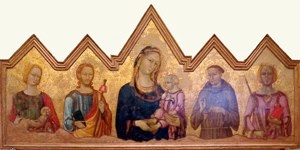
This dossal, which has recently been attributed to the Maestro dei Dossali di Montelabate, was moved from the nuns’ choir to the Galleria Nazionale in 1879. It depicts the Madonna and Child with SS Agnes, James, Francis and Catherine of Alexandria. The dossal was placed in the present frame as part of a restoration in 1920.
Panels from San Tommaso (15th century)
These panels, which are attributed to Giovanni Boccati, are of similar dimensions, and both depict the Madonna with musical angels:
-
✴The panel of the Madonna del Latte, in which the Madonna breast feeds the baby Jesus, was first documented when it was moved to the Accademia di Belle Arti in 1810.
-
✴The heavily repainted panel of the Madonna dei Raccomandati, in which the Madonna shields a number of kneeling lay people under her cloak, remained in the choir of the church until ca. 1880, when it was moved to the Galleria Nazionale.
Both panels are now in the deposit of the gallery. They are illustrated in schedules 32-3 in the catalogue entry by Mauro Minardi referenced in the page on the artist.
Coronation of the Virgin (ca. 1528)
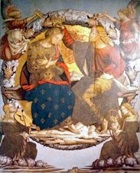
Incredulity of St Thomas (1530s)
This altarpiece, which is attributed to Giannicola di Paolo and dated on stylistic grounds to the 1530s, was on the high altar of the church until 1879, when it moved to the Galleria Nazionale. It depicts the risen Christ standing in a landscape, while St Thomas examines the wound in His side and St John the Evangelist records the scene for his gospel. To the right, SS George, Benedict and Antony Abbot look on. The figures of SS Dominic and Antony Aquinas to the left were added later, almost certainly after 1555, when the nuns were transferred from the Cistercian to the Dominican Order: they possibly replaced an original figure of St Bernard of Clairvaux, the Cistercian founder.
The altarpiece was replaced by a copy (1881) by Ludovico Caselli, which the nuns took with them when they moved to the Monastero della Beata Colomba in Corso Garibaldi. It is now on the left wall of the church there.
Deposition of Christ (16th century)
This altarpiece, which was moved from San Tommaso in 1863 and is now in the Galleria Nazionale, is somewhat tentatively attributed to Orazio Alfani. It was badly restored and partly overpainted in 1935-40.
Madonna della Rosario (17th or 18th century)
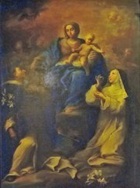
Read more:
F. Terrano, “La Chiesa e il Monastero di S. Tommaso in Perugia: Profili per un' Indagine Storico-Artistica”, Bollettino della Deputazione di Storia Patria per l' Umbria, 102:1 (2005) 59-98
Return to Nunneries of Perugia.
Return to Monuments of Perugia.
Return to Walk VI.

